|










|
 Turtles in Crisis: The Asian Food Markets
James E. Barzyk
Turtles in Crisis: The Asian Food Markets
James E. Barzyk
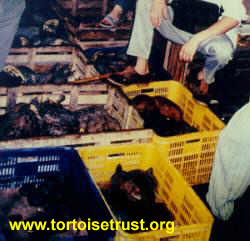
|
Guangzhou Market, China
Turtle vendors and their daily inventory of wild caught
turtles and tortoises. |
Centuries old Chinese trade routes spread like fingers throughout Asia
bringing the fauna of the continent into their food markets. By now, we
are accustomed to seeing images of these animals horrifically mistreated
while waiting to be sold for food, traditional Chinese medicines or in
the rare instance to be released as a good luck omen. What is new
here is that the trade in turtles and tortoises, most of which have been
captured in the wild, has become massive. When the Chinese currency recently
became convertible, it made turtles and tortoises a cash commodity, putting
demand pressure on supplies in other Asian countries, who until then, had
used the turtles for their own local consumption.
Considerations and Implications of the Food Markets
In order to meet the increased demand from China, harvesting methods
of wild turtles and tortoises had to be successful enough to achieve
commercial feasibility. Apparently successful enough that in 1996,
7,716,000 pounds (3.5 million kg.) of turtles were
imported and consumed in Hong Kong alone. The most common turtle found in this
market was Mauremys mutica. Averaging 2 ½ pounds
(1.2 kg.) each, that equals well over 3 million turtles in one year
(Bosco Chan, pers. com. report to TRAFFIC Hong Kong, in preparation).
However, the markets are indiscriminate as to species, and include 80 pound
(36 kg.) adult Orlitia borneensis and 31/2 ounce (100 gram) Geomyda
spengleri, so the number of turtles in absolute terms varies. In 1993
approximately 200,000 – 300,000 individual turtles and tortoises were exported
from the Cau Mong market in Ho Chi Minh City. Approximately
100,000 of these were Indotestudo elongata (Jenkins 1995).
Harvesting methods for the food markets are as varied as the species
found in the markets themselves. Turtles are speared, netted, trapped,
caught with hook and line, and dug out of the mud during low water periods
or while aestivating. Dogs and pit traps are used for many of the
forest floor dwelling turtles including Cuora galbinifrons, Heosemys
spinosa, Indotestudo elongata and Pyxidea mouhotii.
Platysternon are captured on lines using baited straight pins (C.
Hansen pers.com.)
However, in order to gauge the thoroughness of the destruction of the
turtles of Asia we must consider the three prong attack on the river turtles;
the collection of adults, harvesting of eggs and destruction of habitat.
This for example, has led to a reduction of Batagur baska in peninsular
Malaysia by over 90% in the last century (Jenkins 1995).
The situation in Thailand is certainly no better. Maxwell (1911)
calculated 2,600 Batagur baska and Kachuga trivittata nesting
communally in the Ayeyarwady river delta in 1890. By 1899 this population
was down to 820, while in 1982 the same area accounted for “only a few”.
Most recently, a United Nations Development Program found none (van Dijk 1997).
Callagur borneensis, Batagur baska, Kachuga trivattata and the
larger riverine softshell species are captured by a technique that targets
nesting females. Lines of hemp or nylon are suspended several inches
above the riverbanks between poles stuck in the sand so the line runs parallel
to the water line. From this line dangle fish hooks which snag the turtles as they cross under the wire to nest and imprisons them while they await collection by the turtle hunters.
This technique effectively removes the breeding females from the populations.
Eggs are harvested from the few nests that are managed by females eluding
the hooks. More recent perils to these species include “sand
mining” and dam construction. Dams alter water height, eliminating nesting sites and in some cases precluding access to the shoreline altogether. The sandy riverbanks, which serve as traditional communal nesting sites are literally being scooped out and removed. As the need for sand for construction increases so does the destruction of the habitats themselves affecting all the wildlife, including turtles.
Harvesting for the food markets is by no means limited to professionals.
Local peoples are also able to cash in utilizing the ubiquitous “reverse
pet shops”. In the villages and hamlets of the Asian countryside,
these shops purchase animals of all sorts from the local peoples who collect
turtles and tortoises whenever they are encountered. From these shops
the turtles and tortoises make their way to the middlemen who then transport
them across borders if necessary into the larger Asian and Chinese cites.
Mislabeled as seafood, the turtles and tortoises are stacked in wooden
crates violating International Air Transport Association (IATA) shipping
regulations. They are also hauled over land in buses and trucks.
These journeys can take up to several weeks. The trade in turtles is brisk, highly developed and ignored by border guards, customs officials and airline personnel on both the export and import sides
of the Asian borders.
 |
Guangzhou Market, China
CITES Appendix I species from throughout Asia are routinely
found in these markets, in this case Geoclemys hamiltonii. |
Flagrant disregard for any and seemingly all international conservation
laws are routine as a visit to the markets in Hong Kong, Guangzhou, and
Shenzhen will show. The Convention of International Trade of Endangered
Species (CITES) prohibits export and import for commercial purposes of
species listed as Appendix I. Despite this, Aspiderates gangeticus,
A. Hurum, Batagur baska, Geoclemys hamiltonii and Morenia ocellata
(all CITES Appendix I), are routinely available in these Chinese food markets.
None of these five species are found naturally in China. Das (1990),
reports that “large amounts” of Aspidereates gangeticus and A.
hurum, are exported from Bangladesh to the Southeast Asian markets.
Husain & Sarker (1995, revised 1997) report similar findings as well, additionally reporting that turtles are collected in the winter months when females are gravid.
Recently Viet Nam has been enforcing their own conservation laws and
stopping overland shipments headed into China at Lang Son, Dong Deng and
Ninh Binh. Forest Protection Department (FPD) officers in Ninh Binh, a
provincial city south of Hanoi, seized a shipment of 700 turtles.
The confiscated contraband turtles were taken to the newly created turtle
rehabilitation center at Cuc Phong. An FPD officer was
quoted as explaining, “The price you can get (for animals) in Laos is
cheap so they ship them to Viet Nam where the price is good. But
the price in China is better” (D. Hendrie 1998)
In November 1998, 250 tortoises (species unknown) were stolen from the
Kek Lok Si temple in Malaysia. Concerned that the tortoises were
destined for the food markets and “would end up in cooking pots”,
Abbot Seck Jit Heng was quoted as saying that slaughtering these tortoises
for food would contravene the tenets of Buddhism. It is difficult
to imagine this theft, as releasing a turtle or tortoise into a temple
is considered an act of great charity, to be rewarded in ones next incarnation.
Perhaps the wild populations have dwindled to such an extent that measures
such as these are now necessary.
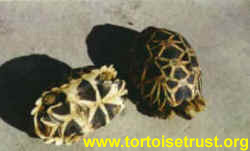 |
Geochelone platynota
The very rare Burmese star tortoise is an excellent example
of the inadequacies and counterproductive policies CITES has regarding
endemic species. This pair was photographed at a snake farm in Hangzhou,
China. Photo compliments of Scott Solar |
The inadequacies and archaic political nuances of CITES itself is proving
to be a virtual death sentence for many endemic species. For example,
the rare Burmese star tortoise, Geochelone platynota, endemic to
Myanmar (Burma), has been found in the Guangzhou and Shenzhen markets in
China. Because Myanmar has apparently not issued CITES II
export permits, NONE can be legally imported into any country, whether for food or ex situ
captive reproduction, despite their occasional availability in the Chinese food markets.
In Asia you can eat them, boil them, butcher
them, sell them, destroy their habitat but you cannot legally export, hence
import any for captive reproduction, which may be their only hope for survival
as a species. Keep in mind that as a note to the original description
of the Burmese star tortoise (Blyth 1863 in Gunther 1864) states that the
indigenous peoples were so fond of eating them that it was very difficult
to obtain a living specimen.
Hopefully CITES will realize that endemic
species cannot be “owned” by a single country and when that country cannot
and does not protect the endemic species found within its borders, will
take action, or at the least allow responsible conservation groups to do
so.
A similar situation regarding Madagascar’s endemic
chelonians is unfolding. Radiated tortoises, Geochelone radiata, flat
tailed tortoises, Pyxis planicauda, and spider tortoises, Pyxis
arachnoides are openly offered for sale as holiday feast foods in Tulear
and Ft. Dauphin. The Mahafaly and the Antrandroy, who consider it taboo to
touch or eat tortoises are now induced by cash to sell them. At hotels,
markets, gas stations – most everywhere where travelers and tourists stop
in southern Madagascar within the range of these tortoises – they are
offered for sale for 2000 – 2500 Fmg ($1 US = 5700 Fmg). From here they
make their way, sometimes by sea, to the Asian food markets and the
Japanese pet markets.
The coastal areas south of Tulear to south of Lake Tsimanampetsotsa and
west of Ft. Dauphin to Faux Caphave had recently contained viable
populations of these tortoises. However, recent expeditions in 1999
revealed these areas now devoid of tortoises indicating these areas as the
source of the market tortoises. Now the flat tailed tortoise, Pyxis
planicaauda, whose habitat is measured in hectares, not square miles, is
recognized as being as critically endangered as the plowshare tortoise, G.
yniphora. Madagascar has a history of not protecting its endangered
wildlife as evidenced not only by this information but by the infamous
Geochelone yniphora incidents.
The discovery of several new species of turtles is further evidence as to just how efficient and thorough the turtle harvesting in Asia has become.
Starting in the 1980’s several species have been discovered
as a result of market activities and most remarkably, to date, none of
these have ever been observed in situ by any one other than the harvesters
and local peoples themselves.
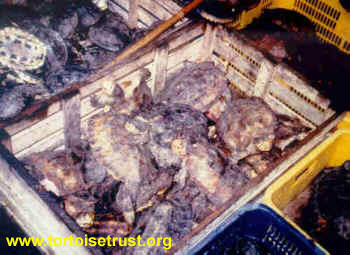 |
Guangzhou Market, China
The recently described Geomyda yuwonoi can be
seen in abundance in this market photo. |
There is no natural history information or exact range statistics for
the newly described Cuora mccordi (Ernst 1988), Cuora serrata
( = Cuora galbinifrons serrata McCord 1992), Cuora zhoui
(Zhao1990), Geomyda yuwonoi (McCord, Iverson & Boeadi
1995), Mauremys iversoni (Pritchard and McCord 1991), Ocadia
glyphistoma (McCord and Iverson 1994), Ocadia philipenni (McCord
and Iverson 1992), Platysternon megacephalum shiui (Ernst &
McCord 1987), Sacalia psuedocellata (Iverson & McCord 1992)
and another yet to be described Cuora.
On a side note, recent German expeditions into Viet Nam have led to
descriptions of two Cuora galbinifrons subspecies; C. g. bourreti
(Obst and Reimann 1994) and C. g. picturata (Lehr, Fritz and Obst
1998) as well as Cyclemys pulchristriata (Fritz, Gaulke & Lehr 1997) and
Pyxidea mouhotii obsti (Fritz, Andreas & Lehr 1998).
These discoveries are very exciting from a taxonomic standpoint.
However, it is sad to point out that the number of known specimens
of these “new species” from a biological standpoint is miniscule.
For example, a single male Cuora aurocapitata was found in the Shanghai
food market in 1997 (I. Pauler pers. com.). In 1996 and 1997 there
were no reported specimens of Cuora mccordi in the Paise food
market were they were originally found and no Cuora zhoui in the
Nanning food market, where they were originally found (O. Shiu pers.com.).
Since then a “very few” C. mccordi were sighted in Paise in 1998
(O. Shiu, pers. com.). To date, there are perhaps no more than 350
C. mccordi known to exist, all of which came out of the food markets
and now are in private or zoo collections, many of which are in Japan.
Despite this grim outlook, survival prospects for C. mccordi, in
particular, are promising. C. mccordi adapts well to
captivity and is consistently reproducing. Further, there have been
no sightings of Ocadia glyphistoma since 1996, and no sightings
of either Ocadia philipenni or Sacalia psuedocellata since
1990 (W. McCord pers.com.). There are, perhaps, too few of
these three species in captivity to expect captive reproduction to be an
option in saving these from extinction. These findings are
relative to a market scenario as previously described in Hong Kong in 1996
and Ho Chi Minh City in 1993.
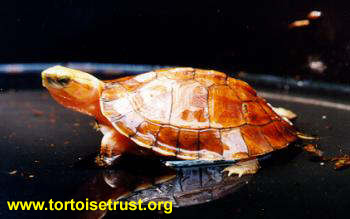
|
Cuora mccordi
These extremely beautiful turtles are very hardy and
responsive. They are breeding quite successfully in captivity, exemplified
by this 18 month old specimen. Photo - Mighty J |
It may well be that some of these newly described turtles were not as
rare as their having been recently discovered would lead one to believe.
A distinct possibility is that their natural ranges are very restricted
and remote. Consider the diversity and range of Graptemys
in the US and Homopus in Southern Africa. Both of these genera have
congeners living in relatively close proximity to each other yet separated
by natural barriers. This does however, reinforce the need for both
in situ conservation and ex situ captive reproduction of Asian chelonians,
as these species are even more vulnerable to extinction due to the market
implications presented herein.
“Rediscovery” of the ultra rare Geomyda depressa occurred in
1995 when a local peasant presented two specimens to a dealer in the Ruili
food market in China. The last prior recorded siting of this turtle
was in 1908, which until that point was the sixth specimen known to exist.
Since this remarkable finding there are have been approximately another
40 specimens of this rather large gregarious turtle which have been found,
all having come out of Ruili. Indications are that G. depressa
does not do well in captivity. The only two captive reproduction
programs for G. depressa are hindered by the complete void of natural
history information of this turtle and further exacerbated by confusion
as to where the natural range of G. depressa actually is.
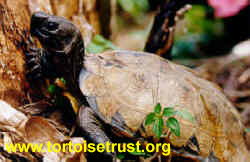
|
Geomyda depressa
This adult female is part of a captive breeding group
located on Hawaii. It is thought that the climatic conditions at
this Hawaiian location are very similar that of H. depressa’s
natural range. Photo - Mighty J |
Turtle Farming in Asia
Turtle farming or ranching as an alternative to further decimation of
wild populations does not seem to be an option. Not only is it a
case of too little too late, it appears that turtle farming in Asia is
limited to Pelodiscus sinensis, the Chinese softshell. Softshell
farms in Thailand have produced as many as six million hatchlings of P.
sinensis in a single year. Unfortunately, attempts of applying
the same farming techniques to other Asian softshells species have not
succeeded.
It is generally considered that hard shelled turtles and tortoises grow
too slowly for them to become economically attractive for farming.
Historically, the market prices for most hard shelled turtles and tortoises
had been generally similar regardless of species. An exception
to this is Cuora trifasciata, which traditional Chinese medicine
places a higher value on, consequently driving up demand and price.
This has resulted in small scale grass roots type “ranching” of C. trifasciata
in China, the scale of which is unknown. The Vietnamese people are
fond of keeping Geomyda spengleri as pets and in these instances,
breeding is known to occur.
In 1997 and 1998 an influx of neonate Cuora flavomarginata,
Ocadia sinensis, Mauremys mutica, and to a lesser degree, Cuora
galbinifrons and Pyxidea mouhotii have appeared in the
Mong Kok pet markets in Hong Kong (pers. ob.). Questions were raised
as to the possibility that these were farm raised. It was even considered
that these were from a US source, but these neonates, no doubt, are of
Asian origin. (Bosco Chan, pers. com.)
Whereas these possible farming instances are not feasible for food market
distribution, due to the small size of the turtles, they may be well suited
to pet market economics. Commercial opportunities from the
pet sector could provide the necessary incentive to ranch the hard shell
species thus creating a self sustaining supply and becoming a de facto
conservation activity, perhaps buying some time for these species.
Captive Breeding
The degree to which captive husbandry succeeds with Asian turtle and
tortoise species varies widely. Cuora galbinifrons, Morenia petersi,
Pyxidea mouhotii and perhaps to a lesser degree Geomyda spengleri
have histories of high mortality. Stress, dehydration and parasite
infestation, play a large role in the demise of the “pets”. It is
very important to note that Asian turtles imported into Europe and the
US for the pet and collector trade, come out of the food markets and as
such, long term survivability of the specimens was never an agenda.
However, many survive and now these animals can and do play a role in captive
propagation.
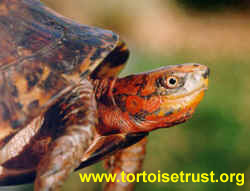
|
Cuora galbinifrons galbinifrons
Despite being relatively common in the US, there are
to date very few captive propagation programs for the very colorful Asian
“flower back” box turtle. Photo - Mighty J |
Recent advances in drug protocols have helped tremendously in the eradication
of detrimental, potentially fatal, parasite infestations typically associated
with Asian food market turtles. Increasing survivorship of imported
specimens, especially the more sensitive species, is helping tremendously
in establishing founder stock for ex situ captive reproduction programs.
Richard Fife, a pioneer herpetoculturist and accomplished breeder of
tortoises and lizards has reported that after administration of drug protocols
to eliminate gastrointestinal parasites and probiotic paste to re-establish
gut flora, a group of Heosemys spinosa, have become “aggressive
feeders……They come out aggressively after their food and even stand on
three legs trying to reach a piece of banana held just out of their reach”.
What is most significant is that these H. spinosa, along
with specimens of Cuora flavomarginata, C. galbinifrons bourreti, C.
galbinifrons galbinifrons, C. serrata and Pyxidea mouhotii were
rescued from the Guangzhou food markets by Mr. Fife and now serve as
viable breeding groups. There is absolutely no doubt, that if not
for Mr. Fife’s actions, all of these particular turtles would have been
consumed in China. So, in effect, these particular turtles
were not only saved, but now fulfill a role as founder stock for a viable
breeding situation.
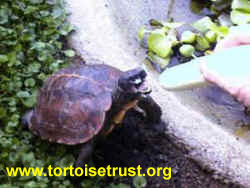
|
Heosemys spinosa
This adult was rescued from the Guangzhou food market
and is now part of a captive breeding program in Arizona.
Photo - Richard Fife |
The American Zoological Association is finalizing plans for a studbook
for the genus Cuora. These plans consider inclusion
of private breeders and collectors. Ex situ captive reproduction
of Asian chelonians has been largely inconsistent, however, a few dedicated
individuals have developed husbandry and breeding techniques for many of
the Asian species. This information is now available and should allow
others to succeed with captive propagation programs as well. To date,
Coura amboinensis, C. aurocapitata, C.
flavomarginata, C. galbinifrons galbinifrons, C. galbinifrons
bourreti, C. mccordi, C. trifasciata, Chinemys reevesi, C. nigricans (=
kwangtungensis), Geoclemys hamiltonii, Geomyda spengleri, Heosemys grandis, H. spinosa, Indotestudo elongata,
Indotestudo forstenii, Manouria emys phaeryi, Mauremys (revised from
Annamemys) annamensis, Mauremys japonica, Mauremys mutica,
Ocadia sinensis, Pyxidea mouhotii, and Sacalia bealei have all
reproduced in captivity in zoos or private collections. However,
many of these are isolated instances.
Based on the long term captive survival experiences with Cuora pani,
C. serrata, Cyclemys dentata, C. tcheponensis, Malayemys subtrijuga, Manouria
emys emys, Notochelys platynota, Platysternon ssp., and Sacalia
quadriocellata, in both zoo and private hands, there is every reason
why captive propagation of these species can succeed. With good fortune
maybe even Geomyda depressa will reproduce. What is lacking
are sufficient founder animals, effort and commitment.
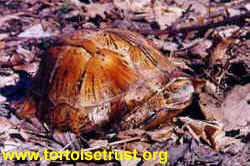
|
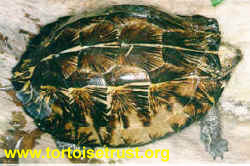
|
Cuora serrata
This “red” phase” adult female is thought to come from
Viet Nam and Laos. C. serrata was described in 1992 as a subspecies
of Cuora galbinifrons, however, some now believe serrata to
be a synonym of C. g. galbinifrons, while others believe it rates
full species designation. Photo - Mighty J |
Cuora serrata
A black phase adult female reportedly from the central
highlands of Hainan Island, China.
Photo - Mighty J
|
An Appeal for Help
Captive breeding should become the goal of anybody keeping more than
a few of these turtles. Conservation and responsible herpetoculture
can no longer afford to condone the typical collection consisting of a
few specimens of numerous species or individual “trophy” specimens.
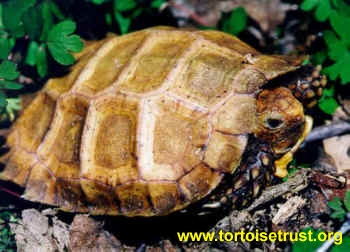
|
Manouria impressa
Captive born M. impressa. Photo - Mighty
J |
Every effort should be made to maintain these species in sexually and genetically
diverse groups ofa minimum of six or eight specimens. Only in this way can we
learn all that is necessary and accomplish what is essential to help save
the turtles and tortoises of Asia. Their plight in the Asian food
markets is certain death whether in a medicine jar, or a cooking pot.
In wild they face the bulldozer, the chainsaw and slash and burn forest
fires like those witnessed in Indonesia in 1997. Some focus and effort
on the part of herpetoculturists worldwide to breed the turtles and tortoises
of Asia can well contribute to nothing less that their surviving extinction.
This could well be the last best hope to ensure survivability of many
of these species, especially when one considers the low reproductive rate
and the long time required for many turtles to reach sexual maturity.
Taken in context of the aforementioned onslaught these turtles face, captive
reproduction seems essential. Larger questions of possible repatriation
of captive bred progeny may not be answerable until such time as the moral,
ethical and technological issues confronting the environment and the turtles
themselves are solved. This may in effect become a multi generation
exercise. Captive reproduction programs can therefore be rationalized as
caretakers until such time in the future when these larger issues are resolved.
At the very least, the turtles and tortoises of Asia will then have options
they certainly would not have had otherwise as the current food market
scenarios may well be taking many of these species into extinction.
The options at that point become rather limited don’t they?
If you are interested you can help. No doubt there are many
well established, long term captive specimens of the species mentioned
here that are in non breeding, genetically dead situations. Those
specimens can and by all means should be consolidated into established
groups. If you have such a situation or if you need any husbandry
information not available in the care please contact Darrell
Senneke at the Tortoise Trust USA.
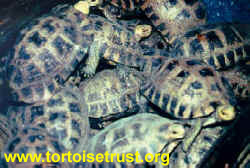
|
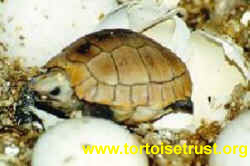
|
Guangzhou Market, China
Indotestudo forstenii listed as CITES Appendix
II, probably from Indonesia. |
Indotestudo elongata
This captive bred hatchling presents a stark contrast
to the previous photo of its congener, Indotestudo forstenii.
Photo Darrell Senneke |
Acknowledgements:
Bosco Chan contributed immensely for his timely updates on the Hong
Kong markets. Thanks to Oscar Shiu, James Buskirk, Chris Hansen and Richard Fife
for information and inspiration. Special mention to Dr. W. McCord
for braving it out and visiting and documenting the markets in Guangzhou
and Shenzhen. John Behler, Dave Collins and Rick Hudson for their efforts
and recognition of this situation. Sincere appreciation to the Tortoise
Trust USA for providing this forum and Darrell Senneke for his valuable
comments.
References:
Husain, L. and Sarker, S.U. 1995. Population, Eco-Biological Status,
Captive Propagation and Conservation Problems of Lissemys punctata
in Bangladesh. Proceedings, International Congress of Chelonian Conservation.
SOPTOM, Gonfaron, France, pp.43 – 46.
Jenkins, M.D. 1995. Tortoises and Freshwater Turtles: The Trade in Southeast
Asia. TRAFFIC International, Cambridge, United Kingdom.
van Dijk, P.P. 1997. Turtle Conservation in Myanmar: Past, Present and
Future. Proceedings: Conservation, Restoration and Management of
Tortoises and Turtles – An International Conference. New York Turtle
and Tortoise Society, pp. 265 – 271.
Supplemental Photos:
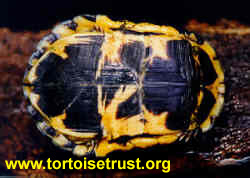
|
Cuora aurocapitata
This species was misidentified as Cuora pani in
Turtles of the World. C. aurocapitata is distinguished
by a lemon yellow head and streaked dark pigment associated with plastral
seams as seen here.
Photo - Mighty J |
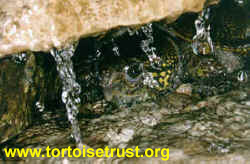
|
Platysternon megacephalum shiui
The female barely visible here is in a captive habitat
designed specifically to replicate the rocky mountain streams which Platysternon
inhabits throughout their natural range.
Photo - Mighty J |
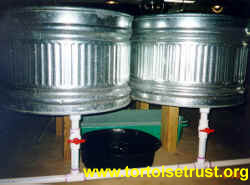
|
Captive Habitat for Semi Aquatic Turtles
These 3’ x 8’ stock tanks features a PVC flush / drain
system which accommodates shallow water environments preferred by forest
floor or pond dwelling species such as Cuora amboinensis, C. galbinifrons,
Pyxidea mouhotii or Heosemys spinosa. It has been the
authors experience that water changes stimulate breeding activity. Photo
- Mighty J |
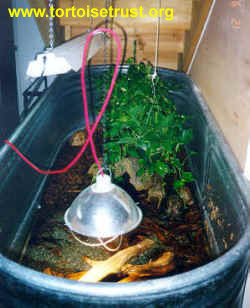
|
Captive Habitat for Semi Aquatic Turtles
Fluorescent lighting is supplemented with clear infra
red bulbs to provide a small basking areas for thermoregulation.
Numerous hiding places provide cover for forest floor dwelling species.
Photo - Mighty J |
All information and photos used in these pages is copy
written, Any use other than personal of the information or photos
tendered here without the express written consent of the author and / or
the Tortoise Trust USA will be subject to legal action.
|

![]() Turtles in Crisis: The Asian Food Markets
James E. Barzyk
Turtles in Crisis: The Asian Food Markets
James E. Barzyk
















